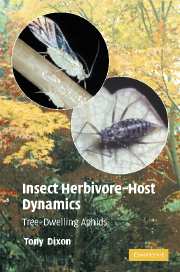Book contents
- Frontmatter
- Contents
- Preface
- 1 Introduction
- 2 Tree-dwelling aphids
- 3 Trees as a habitat: relations of aphids to trees
- 4 Trees as a habitat: relations of aphids to their natural enemies
- 5 Carrying capacity of trees
- 6 Aphid abundance
- 7 Population dynamics
- 8 Risky dispersal
- 9 Seasonal sex allocation
- 10 Aphids and tree fitness
- 11 Rarity, conservation and global warming
- Epilogue
- References
- Species index
- Subject index
4 - Trees as a habitat: relations of aphids to their natural enemies
Published online by Cambridge University Press: 08 August 2009
- Frontmatter
- Contents
- Preface
- 1 Introduction
- 2 Tree-dwelling aphids
- 3 Trees as a habitat: relations of aphids to trees
- 4 Trees as a habitat: relations of aphids to their natural enemies
- 5 Carrying capacity of trees
- 6 Aphid abundance
- 7 Population dynamics
- 8 Risky dispersal
- 9 Seasonal sex allocation
- 10 Aphids and tree fitness
- 11 Rarity, conservation and global warming
- Epilogue
- References
- Species index
- Subject index
Summary
An abundance of prey generally attracts large numbers of a diverse array of natural enemies. This is very true of the sycamore aphid, which is attacked by a large number of parasitoids and insect predators (see Table 6.4) that differ in taxonomy and tactics. As they all feed on the sycamore aphid, then following Root (1967), they constitute a guild. In jointly exploiting a patch of prey the members of a guild may affect one another's foraging success. This interaction, however, differs from competition in that one participant, the predator, accrues immediate energetic gain as well as reducing potential competition. Because of the way this guild is structured the most important interactions are likely to occur between the immature stages of the natural enemies and the parasitoids are more likely to be adversely affected than vice versa. Below is an account of the most frequently encountered natural enemies of the sycamore aphid.
PARASITOIDS
The larval stages of parasitoids develop either internally or externally upon a single host, the latter eventually dying as a result of the attack. The adults are, with few exceptions, free-living and their food source is usually distinct from that of the larvae.
Primary parasitoids
The sycamore aphid has four specific primary hymenopterous parasitoids: the chalcid Aphelinus thomsoni Graham and the braconids Monoctonus pseudoplatani Marshall, Trioxys cirsii Curtis and Dyscritulus planiceps Marshall. The adults of these four wasps usually insert a single egg into the body cavity of its host sycamore aphid.
- Type
- Chapter
- Information
- Insect Herbivore-Host DynamicsTree-Dwelling Aphids, pp. 43 - 53Publisher: Cambridge University PressPrint publication year: 2005



